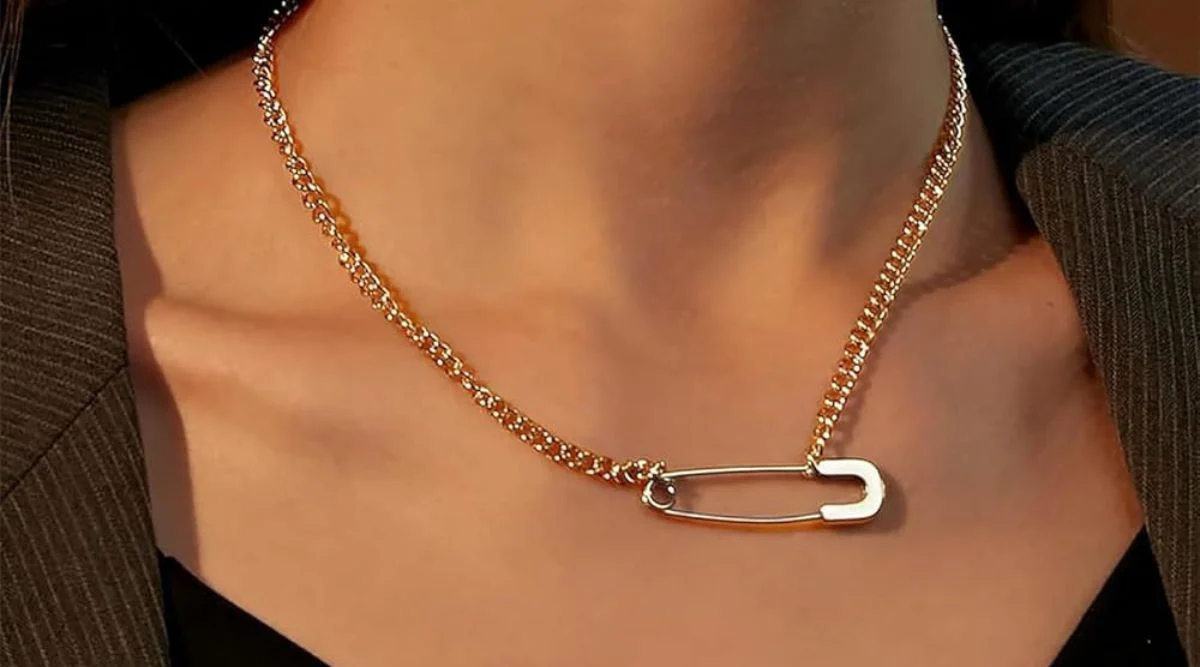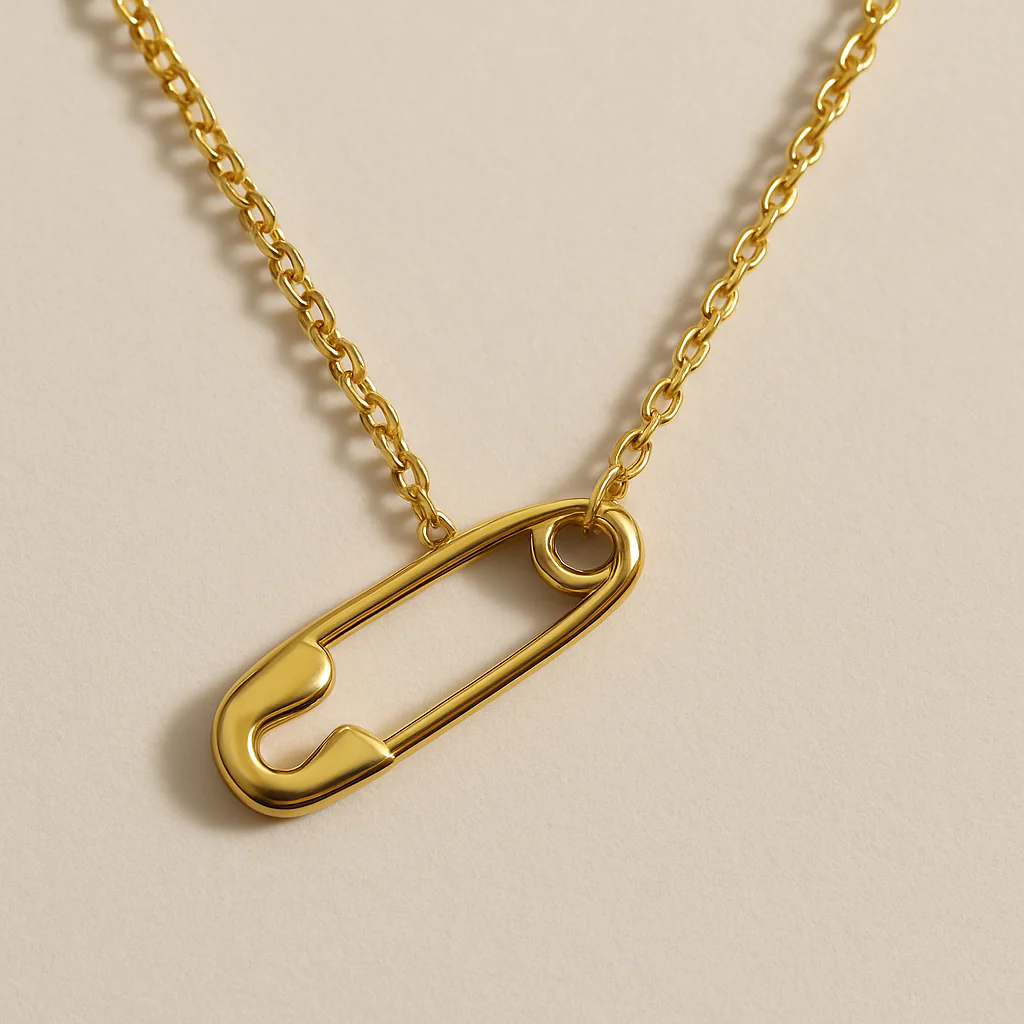A safety pin necklace meaning carries more than decorative appeal. It functions as a symbol with layered meanings: of identity, protest, solidarity, and protection. This article defines its roots, traces evolution, interprets modern uses, and offers guidance on how to wear or interpret it.

Origins: From Fastener to Fashion Symbol
Invention & Mechanical Design
-
The safety pin is a variation of the classic pin: it includes a clasp and spring mechanism to cover the sharp point.
-
Walter Hunt is credited with inventing the modern safety pin in 1849.
-
Its early purpose was purely functional: fastening cloth, repairing tears, holding patches.
-
A predecessor is the fibula, used in ancient Greece and Rome, as a brooch-like fastener.
Thus, the safety pin began as a utilitarian tool. Over time people re-imagined it as a cultural signifier.
Punk Reappropriation: 1970s & 1980s
-
In 1970s punk subculture, safety pins became a visible emblem of rebellion.
-
Punk adherents used safety pins to repair ripped clothing or pierce garments—turning utility into statement.
-
The punk aesthetic was anti-mainstream; using everyday objects as jewelry challenged fashion norms.
-
Designers later adopted the motif: for instance, a famous Versace dress held by gold oversized pins blurred line between couture and punk.
Punk thus transformed the pin into a sign of nonconformity and DIY ethic.
Core Symbolic Layers
A safety pin necklace may evoke several interlocked symbolic layers. These layers often overlap.
1. Solidarity & Allyship
-
After the 2016 Brexit referendum, people in the UK wore safety pins to signal “I am safe to approach for you.”
-
After the 2016 U.S. election, the trend migrated to America as a low-visibility marker of support for marginalized groups.
-
Media articles interpret this usage as a “quiet gesture” of inclusion and acceptance.
-
In celebrity culture, these gestures sometimes spark debate between virtue signaling versus genuine solidarity.
Thus, safety pin necklaces may function as visual signals of empathy and allyship.
2. Rebellion & Identity
-
Because of its punk history, the pin recalls resistance against norms.
-
Some wearers use it to signal alternative identity, rejecting mainstream fashion.
-
It can also assert autonomy: “I wear what I choose,” even if that choice is minimal.
3. Protection & Binding
-
The safety pin’s mechanical purpose—to hold things together—serves as metaphor for protection and unity.
-
Some wearers see it as a talisman: binding wounds, preventing harm.
-
In certain cultures, people attach safety pins to children’s clothes to ward off evil or misfortune.
4. Personal Pledge & Inner Meaning
-
In modern communities, some interpret wearing the pin as a self-promise: a daily reminder not to harm oneself or to persist through hardship.
-
Others adopt it privately: as a mental health emblem or symbol of internal resilience.
-
Some online discussions (e.g. in fandom or social media) claim that wearing or removing it might relate to emotional states—but this is speculative, not historically validated.
This multiplicity means that any given wearer’s meaning could combine one or more layers.
Modern Developments & Cultural Shifts
Fashion Integration & Celebrity Influence
-
Designers and brands began reinterpreting the safety pin as a motif in high fashion.
-
Celebrities wearing pin-held garments (e.g. Emily Ratajkowski) helped turn it into a bold visual identity.
-
Pins have also appeared in ear jewelry and as statement pieces at awards.
-
As the motif went mainstream, its subversive edge softened; some critics argue it is commodified.
Internet, Social Media, & Misinformation
-
On Reddit and forums, some fans misinterpret safety pin necklaces as signals of suicide ideation.
-
Viral social media posts sometimes spread unverified claims linking the pin to promises not to self-harm.
-
But historically and in documented symbolism, those claims lack firm foundation.
-
The multiplicity of meanings and the spread on social platforms make the symbol’s interpretation more ambiguous.
Global & Local Variations
-
In India, safety pins sometimes pass as inherited keepsakes; in Eastern Europe (e.g. Ukraine) used in folk belief to ward evil.
-
In youth subcultures like K-pop fandoms, stylists may use pin necklaces for aesthetic reasons with little symbolic intent.
-
In activist circles, safety pin jewelry is deployed during protests or awareness months (e.g. Pride) as a low-cost symbol.
How to Interpret or Wear a Safety Pin Necklace
| Signal / Context | Likely Meaning(s) | Notes & Caveats |
|---|---|---|
| 2016+ protest zone, visible pin | Solidarity / allyship | Often intended to signal “safe person” |
| Punk, edgy outfit, distressed clothes | Rebellion / identity | Primarily aesthetic + subcultural signal |
| Minimalist pin near heart | Personal pledge / internal meaning | May not intend public statement |
| Local cultural use (e.g. child clothing) | Protection, tradition | Rooted in folk belief |
| Celebrity fashion context | Style statement | Use caution assigning deeper meaning |
This table helps guide interpretation without rigid judgment.
A 6 Step Interpretation Checklist
-
Observe context: Is this worn at a protest, in a fashion shoot, on everyday wear?
-
Note style / material: Cheap metal vs gold or designer might hint at aesthetic vs symbolic use.
-
Consider consistency: Is the wearer always wearing it?
-
Look for related cues: Clothing, badges, how they talk about causes.
-
If possible, ask expression: What meaning the wearer attributes.
-
Avoid assumptions: Do not ascribe deep meaning if no evidence.
Use this checklist when you see a safety pin necklace in real life.
Uses & Design Variations
Common Use Cases for Wearing Safety Pin Necklaces
-
Solidarity/allyship in social or political settings
-
Punk / alternative fashion expression
-
Personal narrative or emotional pledge
-
Protection / talisman use in folk or spiritual contexts
-
Statement piece in art, music, or runway settings
-
Sentimental keepsake or heirloom
Design Variations & Customization Ideas
-
Plain metal pin on chain (silver, gold, steel)
-
Oversized decorative safety pin (statement piece)
-
Beaded pin necklace (pins threaded with beads)
-
Charm-added pin (initials, symbols, gemstones)
-
Double or triple pin cluster necklaces
-
Mixed media (wood, resin, metal, wire wrap)
-
Engraved or inscribed pins with dates, words
These lists show how functionality, symbolism, and creativity converge in design.
FAQs About Safety Pin Necklace Meaning
Q1. Does a safety pin necklace always mean solidarity?
No. While solidarity / allyship is a popular meaning, many wearers adopt it purely as aesthetic jewelry, identity marker, or personal pledge.
Q2. Can it signal mental health struggles or suicide ideation?
Some online communities claim that wearing or removing a pin signals such states. But historically there is no documented tradition or credible evidence linking safety pin necklaces to suicide symbolism.
Q3. Is it culturally insensitive to wear one?
Wearing one in support of causes you do not understand or with no action may invite critique of performative activism. Ethics matter more than symbolism.
Q4. What materials should one choose?
Hypoallergenic metals (titanium, surgical steel) are safer for sensitive skin. Precious metals (gold, silver) are common in designer versions.
Q5. How to style it for formal settings?
Use a minimalist design—fine chain, small pin, neutral tones—for elegant contrast. Pair with minimal jewelry so the pin stands out.
Q6. How to preserve or clean a safety pin necklace?
Use gentle jewelry cleaner or mild soap, soft cloth, avoid harsh chemicals. Store in dry place to avoid tarnishing.
Q7. Should one ask someone what their pin means?
Yes—if context allows, politely ask meaning rather than assume. Many wearers regard it as personal.
These FAQs aim to clarify common uncertainties.
Narrative Examples & Cases
Case 1: Protest Context
A person wears a safety pin necklace during a public demonstration. She mixes it with casual clothes. Observers interpret it as allyship. The wearer later states it is meant to say: “I stand with you.”
Case 2: Fashion Editorial
A model in a high fashion photoshoot wears an oversized gold safety pin dress accessory. The stylist intended it as visual metaphor, not political statement.
Case 3: Private Meaning
A young individual wears a simple, matte pin daily. To them, it is a reminder of self resilience. They rarely explain it publicly.
These narratives reflect how the same object shifts meaning by context and intention.
Learn More: Your Topics, Multiple Stories: The Complete Guide to Expanding One Idea into Endless Narratives
How Long Is 120 Hours? Complete Conversion and Practical Guide
Conclusion
The safety pin necklace meaning is not monolithic. It embodies solidarity, rebellion, protection, and personal narrative. Its meaning evolves with wearer, era, and culture.
When you see someone wear one, interpret with nuance: consider context, style, consistency, and if possibl their own explanation. Use the symbol with intention and respect.

